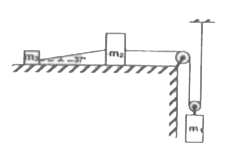Each of the three blocks P, Q and R shown in figure has a mass of 3 kg. Easch of the wires A and B has cross sectional area 0.005 cm^2 and Young modulus 2x1011Nm−2. Neglect friction. Find the longitudinal strain developed ineach of the wires. Take g=10ms−2

The correct Answer is:43×10−4,83×10−4
a=4012=103m/s2
T1=403N,T2=803N
strain in wire 1=403×5×10−7×2×1011=43×10−4
strain in wire 2=803×5×10−7×2×1011=83×10−4
Topper's Solved these Questions
- ELASTICITY AND VISCOCITYBook:RESONANCEChapter:ELASTICITY AND VISCOCITYExercise:Exercise- 1 PART - II
Explore 14 Videos
- ELASTICITY AND VISCOCITYBook:RESONANCEChapter:ELASTICITY AND VISCOCITYExercise:Exercise- 2 PART - I
Explore 11 Videos
- ELASTICITY AND VISCOCITYBook:RESONANCEChapter:ELASTICITY AND VISCOCITYExercise:Advanced Level Problems
Explore 9 Videos
- DAILY PRACTICE PROBLEMSBook:RESONANCEChapter:DAILY PRACTICE PROBLEMSExercise:dpp 92 illustration
Explore 2 Videos
- ELECTROMAGNETIC INDUCTIONBook:RESONANCEChapter:ELECTROMAGNETIC INDUCTIONExercise:Exercise
Explore 43 Videos
Similar Questions
A system consisting of light wires and blocks is released from rest as shown in figure. The coefficient of kinetic friction between the blocks and surfaces is 0.1 and masses of blocks m1,m2 & m3 are 4 kg,4kg and 2 kg respectively. The cross section of the wire between m2 and m3 is 0.003 cm2 and its Young's Modulus is 2×1011N/m2. Calculate
the acceleration of the block m2.
(b) the longitudinal strain developed in the wire m2 and m3.

View SolutionA copper wire of cross sectional asrea 0.01 cm is under a tension of 20 N. Find the decrease in the cross sectional area. Young modulus of copper =1.1×1011Nm−2 and Poisson ratio 0.32.
View Solution
Knowledge Check
Three equal masses 3 kg are connected by massless string of cross sectional area 0.005cm−2 and Young's modulus 2×1011N/m−2. In the absence of friction the longitudes strain in the wire
 AA is 10−4BB is 2×10−4CBoth (a) and (b)DNone the these
AA is 10−4BB is 2×10−4CBoth (a) and (b)DNone the theseEach of three blocks shows in figure has a mass 3 kg. The wire connecting blocks A and B has area of cross-section 0.005cm2 and Young's modulus of elasticity Y=2×1011N/m2 . Neglect friction. Find the elasticity potential energy stored per unit volume in wire connecting blocks A and B in steady state.
(Takeng=10m/s2)
 A500J/m3B1000J/m3C2000J/m3D3000J/m3
A500J/m3B1000J/m3C2000J/m3D3000J/m3The area of a cross section of steel wire is 0.1cm2 and Young's modulus of steel is 2×1011Nm−2. The force required to strech by 0.1% of its length is
A1000NB2000NC4000ND5000N
Consider the situation shown in figure. The force F is equalk to the m2g2. If the area of cross section of the string is A and its Young modulus Y, find the strain develolped in it. The string is lilght and there is no friction anywhere.

View SolutionA steel wire having cross-sectional area 2 mm^(2) is stretched by 20 N. Find the lateral strain produced in the wire Y_("steel") = 2 xx 10^(11) Nm^(-2), sigma = 0.391
View SolutionOne end of a metal wire is fixed to a ceiling and a load of 2 kg hangs from the other end. A similar wire is attached to the bottomof the lod and another road of 1 kg hangs from this lower wire. Find the longitudial strain in both wires. Area of cross section of each wire is 0.005cm2 and Young modulus of the metasl is 2.0×1011Nm−2.Takeg=10ms−2
View SolutionThe area of a cross-section of steel wire is 0.5cm−2 and Young's modulus of steel is 2×1011Nm−2. The force required to stretch by 0.5% of its length is
View SolutionA steel wire 4.0 m in length is stretched through 2.0 mm. The cross-sectional area of the wire is 2.0mm2. If young's modulus of steel is 2.0×1011Nm−2, then find the energy density of wire.
View Solution

